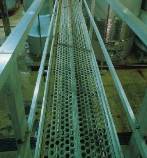“Nothing compares to seeing it in person, first hand.”
I have heard this line countless times, usually in the context of an entertainment event. Now I can say it’s equally true when it comes to seeing an automobile being assembled at a plant.
This week I was one of 125 people to attend the Green Manufacturer Network’s second Zero-Waste-to-Landfill workshop, a one-day event held at Subaru of Indiana Automotive Inc. (SIA) in Lafayette, IN. The vast majority of attendees were manufacturing executives hoping to learn how to make their operations more sustainable, eco-friendly and profitable.
The workshop included a tour of the SIA plant-which became the first zero-landfill plant in the United States in 2004-and various presentations about SIA’s and other companies journeys to zero landfill. While I enjoyed the presentations, the tour was the highlight for me.
The attendees were separated into two groups that were taken on separate tours along a catwalk about 30 feet above the assembly plant floor.
From the catwalk, one gets a wider-lens perspective of the plant, a first-rate view.
For instance, I could clearly see and gain a better appreciation of the enormity of the presses at work in the stamping and tool and die area. I also was able to see the workers in relation to these machines-how, in certain cases, they were leading them, and, in other cases, how they anxiously waited for the machine to stamp out a part so they could do their job.
The robot-and-worker relationship was also of keen interest to me and the rest of the group when we observed the activities in the body shop, where parts receive further treatment before being conveyed or manually moved to the assembly area.
In the body shop work cells, I could clearly see a smooth cooperation between robot and worker, although the latter was definitely in control. The tour operator gave us a few extra minutes to stand and take in this site.

Photo courtesy http://boyle-assoc.com.
Before the plant tour, the parts shortage was just something I’d heard and read about. Now I saw the real-world consequences.
The allotted tour time was quickly passing so our group was brought to the two main assembly lines. From our perspective we could see autos with limited assembly on one line, compared to autos receiving final assembly on the second line.
I also came to a better appreciation of the assemblers’ consistency in, and focus on, their work. Every minute or so another auto was before them that required specific components or fasteners or the joining of some electrical wiring. They know their jobs very well, and, according to the tour operator, usually know the jobs of the other people in their team. On a daily basis, they help out each other as needed and make each other better.
By this point in the tour, we were in the home stretch, so we were brought to the final-testing area where cars are given more tests than I could remember (and write down). I saw and many components and functions being tested-such as brakes, wipers, doors and headlights.
Once a car passed these tests, it was finished and driven out of the plant. Soon it would be shipped to dealers.
The tour leader then told us the tour was finished. Like the just-completed cars, my time in the plant had come to an end.
However, my appreciation of the auto assembly process rolls on.

Recent Comments
Helpful for Trainees
Cable Assembly Manufacturers
Huawei for manufacturing?
should have a scanner and then 3D print the repair
IPC-A-610 and IPC-j-std-001